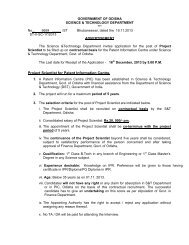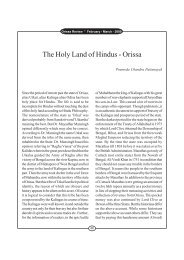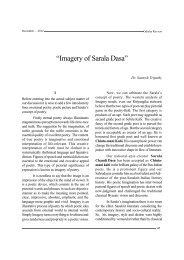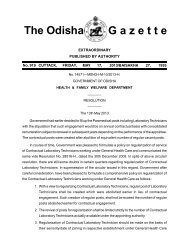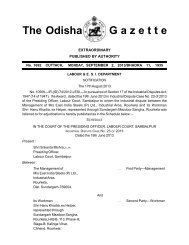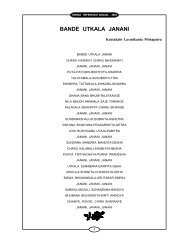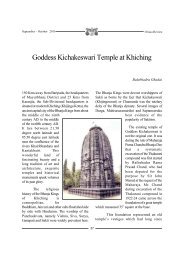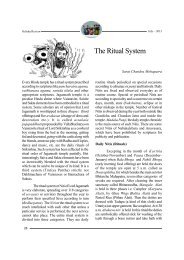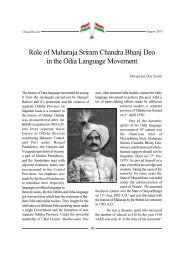Palm- Leaf Manuscripts: The Proud Possessions of Orissa
Palm- Leaf Manuscripts: The Proud Possessions of Orissa
Palm- Leaf Manuscripts: The Proud Possessions of Orissa
You also want an ePaper? Increase the reach of your titles
YUMPU automatically turns print PDFs into web optimized ePapers that Google loves.
PDF<br />
Documents<br />
Complete<br />
Click Here & Upgrade<br />
Expanded Features<br />
Unlimited Pages<br />
<strong>Orissa</strong> Review * November - 2005<br />
Several commentaries were written on wellknown<br />
Sanskrit works. <strong>The</strong>re were also an<br />
outpouring <strong>of</strong> literary works, the best known <strong>of</strong><br />
which are Anargha Raghava <strong>of</strong> Murari Mishra,<br />
Gita Govinda <strong>of</strong> Sri Jayadev and Sahitya Darpana<br />
<strong>of</strong> Viswanath Kaviraj.<br />
By the fifteenth century the art <strong>of</strong> palmleaf<br />
writing had attained great excellence. <strong>The</strong><br />
innumerable copies <strong>of</strong> Sarala Mahabharata were<br />
written on palm-leaf manuscripts and spread<br />
throughout <strong>Orissa</strong>. By the way, the great poet and<br />
the great monarch, Gajapati Kapilendra Dev <strong>of</strong><br />
Suryavamsi dynasty, who ruled <strong>Orissa</strong> at that time<br />
became indelible in history. <strong>The</strong> manuscripts <strong>of</strong><br />
Bhagabata <strong>of</strong> the poet Jagannath Das, had still<br />
far greater influence over the common people <strong>of</strong><br />
<strong>Orissa</strong>. Balaram Dass Jagamohan Ramayana<br />
was also accepted with much reverence for its<br />
lucid style. Practically speaking, these three were<br />
the most widely read books in <strong>Orissa</strong> by that time.<br />
With the advent <strong>of</strong> Shri Chaitanya to <strong>Orissa</strong> in<br />
1510 A.D. and the spread <strong>of</strong> Vaishnavism, the<br />
Oriya Bhagabata achieved unprecedental<br />
popularity. Community houses called Bhagabata<br />
Gharas or Bhagabata Tungi sprang up in the<br />
villages <strong>of</strong> <strong>Orissa</strong> where copies <strong>of</strong> Bhagabat were<br />
kept and recited daily. <strong>The</strong> reading <strong>of</strong> the chapters<br />
<strong>of</strong> the holy scriptures became a daily ritual in the<br />
homes <strong>of</strong> Oriya people. Thus, the Bhagabata<br />
Pothi brought pr<strong>of</strong>ound vibration in the entire<br />
social life <strong>of</strong> <strong>Orissa</strong>.<br />
During the sixteenth and seventeenth<br />
centuries a large number <strong>of</strong> Kavyas or long<br />
episodical poems were written in Oriya, all based<br />
on Krishna theme.<br />
<strong>The</strong> most outstanding <strong>of</strong> these Kavyas are<br />
Bhakta Charan Dass Mathura Mangala, Rupa<br />
Goswamis Bidagdha Madhava and Dina<br />
Krushna Dass Rasa Kallola. Several other<br />
translations <strong>of</strong> Ramayana also appeared, the more<br />
popular ones being the versions <strong>of</strong> Adhyatma<br />
Ramayana by Gopala Telenga and Haladhara Das<br />
and Vichitra Ramayana by Viswanath Khuntia.<br />
Another popular manuscript <strong>of</strong> this period was<br />
Sishu Shankar Dass Ushabhilasha, based on a<br />
story <strong>of</strong> Sarala Mahabharata. New poetic forms<br />
also emerged during this period viz, Janana (song<br />
<strong>of</strong> prayer), Chautisa (songs which followed the<br />
thirty-four consonants <strong>of</strong> Oriya alphabets) and Poi<br />
(referring to the number <strong>of</strong> verses in the poems),<br />
i.e. Dasa Poi - meaning a ten-verse poem.<br />
<strong>Orissa</strong> lost her independence in 1568<br />
A.D. and was successively overrun by Afghans,<br />
Mughals and Marathas. Till the British conquest<br />
in 1803, <strong>Orissa</strong> was a veritable cockpit <strong>of</strong> rival<br />
warlords. <strong>The</strong>re was no peace and security. In<br />
the absence <strong>of</strong> a stable central power, <strong>Orissa</strong><br />
broke up into a number <strong>of</strong> semi-independent<br />
principalities under local Rajas. <strong>The</strong> feudal chiefs<br />
patronized art, music and literature as pastimes.<br />
<strong>The</strong> brilliant literary figures <strong>of</strong> this period<br />
was Upendra Bhanja, who was a prince himself.<br />
A prolific poet, he created volumes <strong>of</strong> literary<br />
works. He was the master <strong>of</strong> ornate poetry and<br />
each <strong>of</strong> his work is an example <strong>of</strong> his mastery<br />
over some particular versifying skill or other.<br />
Through clever manipulation <strong>of</strong> words and with a<br />
liberal use <strong>of</strong> puns, alliterations, assonances and<br />
figures <strong>of</strong> speech, he built up a body <strong>of</strong> poetry<br />
which was gaudy and grandeloquent and at the<br />
same time pedantic and unintelligible. He<br />
composed songs, Kavyas, epics, fictional poems,<br />
rhetorical compositions. Chitra-kavya (picturepoem)<br />
and even a dictionary <strong>of</strong> verse for the use<br />
<strong>of</strong> poets. Vaidehisha Vilas, Koti Brahmanda<br />
Sundari, Prema Sudhanidhi, Lavanyabati are<br />
some <strong>of</strong> his memorable works.<br />
<strong>The</strong> style <strong>of</strong> Bhanja prevailed till the<br />
second half <strong>of</strong> the 19th century. All the poets who<br />
emerged after Upendra Bhanja followed his style.<br />
39



